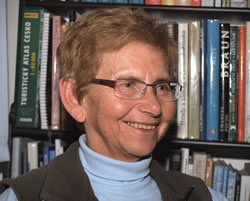
Doctor Dagmar Lieblová, by birth from Kutná Hora, grew and lived in Česká street until she was thirteen years old. But her childhood was very dramatic – read the following story of little Dana from Kutná Hora.
Mrs. Lieblová, what are your memories before the year 1942?
“As it was said before, I was born in Kutná Hora where my father worked as a physician. Here we lived until June 1942, when we were all – which means my parents, younger sister, grandmother and me – deported to Terezín.”
What comes to your mind when you hear the name Terezín?
“Men were accomodated in another part than women. I lived with my mom in womens’ barracks at fi rst, but soon I moved to the so called girls’ home for the girls of my age. During the day we worked in the garden, in the evening we were studying. We had very little food, suffered from vitamin defi ciency and various contagious diseases. Moreover we had to struggle with troublesome insects everyday. But yet, or just therefore, we had a lot of other interests. We were interested in poetry, music, literature and also making friendship, some of them survived till today. The worst was the permanent fear of being transported to the east. The fi rst from our family who was transported was my grandmother, in autumn 1943. The rest of us was transported to Auschwitz-Birkenau in December 1943.”
What followed then?
“After arrival in Auschwitz we were placed to so called family camp. Right away the fi rst night there we were tattooed numbers and all our things were seized. Not long after that we heard about gas chambers. Only in March 1944 about 4000 people from our camp were sent there to die (including my little cousin Tomáš Reitman), who came to Birkenau a half year earlier. After half a year after our arrival they chose all men and women capable of working for the needs of Reich. By chance it was also me who was among those “chosen”. My path continued to other camps in Hamburg and in Bergen-Belsen, where we were liberated by the British Army. My parents and my sister weren’t so lucky, and died in a gas chamber.”
Can you describe your return to post-war Czechoslovakia?
“I returned to Czechoslovakia in summer 1945 and was almost three years undergoing medical treatments. After that I started to study a secondary school and later graduated in German and Czech languages at the Philosophical Faculty of Charles University. During my studies I also got married. I was teaching for instance at the school in the town of Čáslav, at the Language School in Prague, and for the last twenty years at the Translation and Interpretation Department at Charles University. In the sixties me and our children went along with my husband to Moscow and to Ghana where he worked. I was also teaching almost three years in Uppsala, Sweden. Now I am retired and do some translations. We have been married with my husband for 53 years, we have two daughters, a son and six grand children.”
Can you tell us what the Terezín Initiative is and what it deals with?
“Terezín Initiative is an association of former prisoners of the Terezín ghetto, Jewish prisoners of other concentration camps and their children. We founded it in 1990 because before it was very little spoken about Terezín ghetto, as well as about the Czech Jews. We aim to preserve memory of the people who weren’t lucky enough to survive, as well as to have an infl uence on young people and inform them what the holocaust was, and of course to help our members who can get into diffi cult situation due to the old age.”
Note: Dr. Lieblová was in 2011 awarded by the President of the Czech Republic by the Order of T. G. Masaryk of 2nd class.
Mrs. Lieblová, thank you for the interview.
Luděk Sládek
Terezín Initiative
Jáchymova 3, 110 00 Praha 1
Tel.: +420 222 310 681
E-mail: terezinskainiciativa@cmail.cz
Terezín Memorial
www.pamatnik-terezin.cz
Nesouhlas se zpracováním Vašich osobních údajů byl zaznamenán.
Váš záznam bude z databáze Vydavatelstvím KAM po Česku s.r.o. vymazán neprodleně, nejpozději však v zákonné lhůtě.